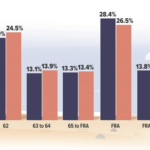 Although there are some immutable concepts in the realm of money and investing, such as “buy low and sell high” and “start early,” the best vehicles for achieving various financial goals tend to ebb and flow over time. That’s definitely true when it comes to saving for children. While U.S. savings bonds might have been the de rigueur gift from grandma and grandpa 30 years ago, settling for their currently meager interest rates seems like a questionable bet right now. And even though UGMA/UTMA–Uniform Gift to Minors Act/Uniform Transfers to Minors Act–custodial accounts might have been one of the best options for college savings a few decades ago, the emergence of 529 plans makes these “kiddie trust” accounts much less compelling now.
Although there are some immutable concepts in the realm of money and investing, such as “buy low and sell high” and “start early,” the best vehicles for achieving various financial goals tend to ebb and flow over time. That’s definitely true when it comes to saving for children. While U.S. savings bonds might have been the de rigueur gift from grandma and grandpa 30 years ago, settling for their currently meager interest rates seems like a questionable bet right now. And even though UGMA/UTMA–Uniform Gift to Minors Act/Uniform Transfers to Minors Act–custodial accounts might have been one of the best options for college savings a few decades ago, the emergence of 529 plans makes these “kiddie trust” accounts much less compelling now.
If you’re saving on behalf of a child, the following options may not add up.
Life Insurance
Buying life insurance for kids fails the sniff test on a couple of separate counts. First, the main reason anyone needs life insurance is to replace lost income–for example, new parents should buy such coverage to provide a financial safety net for their children in case anything should happen to them. But unless your child has a budding career as a model or actor, it’s unlikely that he or she is generating a meaningful level of income that you’d need to replace if something happened to your child. Moreover, while whole (or cash-value) life insurance policies are often pitched as savings vehicles, their long-term rates of return will pale alongside investment vehicles that aren’t as larded with commissions and expenses, such as 529 plans or mutual funds and ETFs.
UGMA/UTMA Accounts
In the scheme of things, UGMA/UTMA accounts aren’t a disaster: It’s better to save for kids’ future than not do so, and these accounts give you the ability to save on behalf of a child without the cost and bother of setting up a trust. UGMA/UTMA accounts also give you wide discretion over the specific investments that you hold. However, if your aim is to build up a child’s college fund, these accounts can backfire for a couple of different reasons.
First, your child will have discretion over any assets in a UGMA/UTMA account when he or she reaches the age of majority (18 or 21, depending on the state). Most parents assume that their children will do the right thing and use the money to pay for college as you intended them to, but you’re definitely ceding a level of control with these accounts. In addition, because the assets in a UGMA/UTMA account legally belong to the child, that can work against your child when it comes time to apply for financial aid.
You can circumvent both the loss of control and financial-aid problems by saving for college within the confines of a 529 plan; the person who sets up the account retains control of the assets, and 529s are treated more favorably in financial-aid calculations than are UGMA/UTMA accounts. (If your child already has UGMA/UTMA assets, it’s possible to fund a 529 plan with that money, thereby obtaining more favorable treatment in financial-aid formulas. This article details the ins and outs of doing so.)
Savings Bonds
For people who value safety, using U.S. savings bonds to save for college might appear to be an attractive option. The bonds are backed by the full faith and credit of the U.S. government (hold the political comments, please). In addition, interest on Series EE and I-bonds might be entirely or partially free of federal tax if the money is used to fund qualified college expenses at an eligible institution, provided your income falls below certain thresholds.
The trouble is that yields are about as low as they can go–currently 0.60% for Series EE bonds and 0.74% for I-bonds, according to Treasurydirect.gov. True, I-bonds’ yields are inflation-adjusted, and higher-yielding bonds may eventually become available, making I-bonds and EE bonds a more viable option for college savings. But for now, given that the inflation rate in college costs (roughly 8% per year currently) is far outstripping the general inflation rate, the math just doesn’t add up for these bonds as a viable college-savings vehicle.
Balanced Funds
Using balanced funds to invest for your kids isn’t a disaster, particularly if you expect to tap the assets within the next five to 10 years to pay for college or some other expense. There’s something to be said for the “set it and forget it” appeal of funds that mix both stocks and bonds together, and recent Morningstar research shows that investors exhibit better timing decisions with balanced funds than they do stock funds. Moreover, there will certainly be times when bonds outperform stocks–the past decade is a prime case in point.
But when saving for very young children for whom college may be 12 or 17 years in the future, it makes sense to take advantage of that very long time horizon by investing primarily in stocks at the outset, then gradually transitioning to heavier weightings in safe assets such as cash and bonds. If you don’t want to do the heavy lifting of asset allocation, nearly all 529 plans offer age-based options that gradually become more conservative as college draws near.
Source: Chrstine Benz http://news.morningstar.com/articlenet/article.aspx?id=378007






